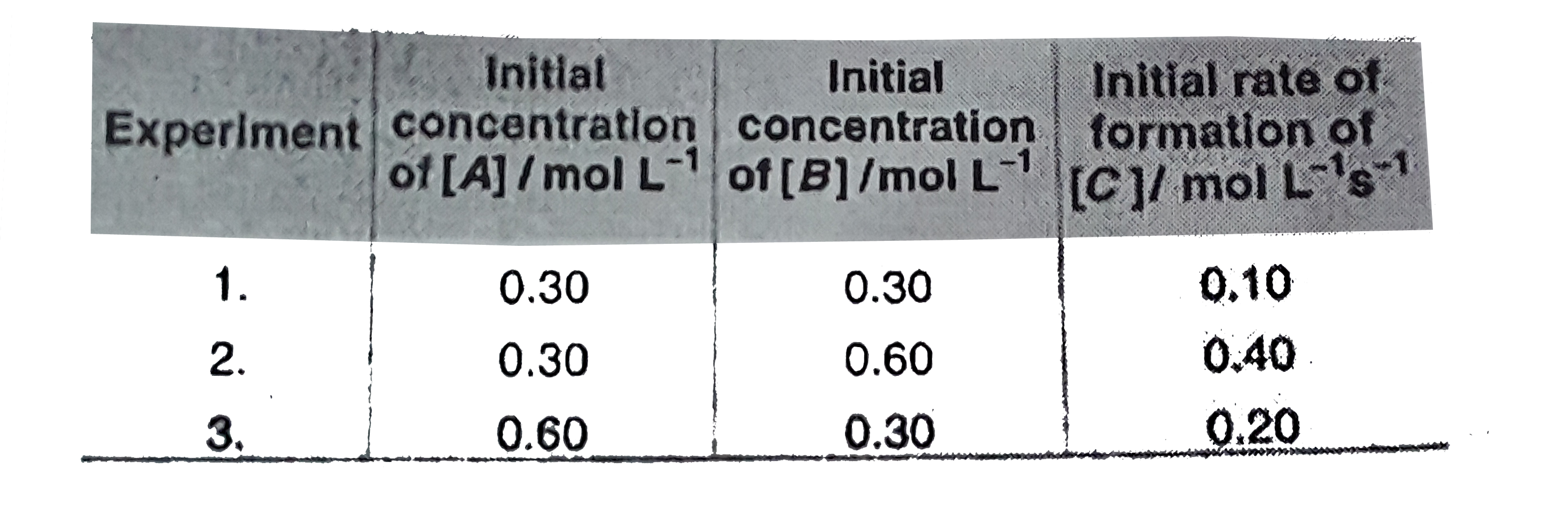Compounds 'A' and 'B' react according to the following chemical equation :
Concentration of either 'A' or 'B' were changed keeping the concentrations of one of the reactants constant and rates were measured as a function of initial concentration. Following results were obtained. Choose the correct option for the rate equations for this reaction.

Rate
Rate
Rate
Rate
The correct Answer is:B
From expts. 1 and 3, [B] = constant, [A] = doubled, rate is doubled.
Hence, Rate .
From expts. 1 and 2, [A] = constant, [B] = doubled, rate quadrupled.
Hence, Rate .
Combining, Rate .
Topper's Solved these Questions
- CHEMICAL KINETICSBook:PRADEEPChapter:CHEMICAL KINETICSExercise:NCERT EXEMPLAR PROBLEMS WITH ANSWERS, HINTS AND SOLUTTIONS (MULTIPLE CHOICE QUESTIONS-II)
Explore 12 Videos
- CHEMICAL KINETICSBook:PRADEEPChapter:CHEMICAL KINETICSExercise:NCERT EXEMPLAR PROBLEMS WITH ANSWERS, HINTS AND SOLUTTIONS (SHORT ANSWER QUESTIONS)
Explore 20 Videos
- CHEMICAL KINETICSBook:PRADEEPChapter:CHEMICAL KINETICSExercise:NCERT EXERCISES
Explore 30 Videos
- BIOMOLECULES Book:PRADEEPChapter:BIOMOLECULES Exercise:IMPORTANT QUESTIONS (FOR BOARD EXAMINATION)
Explore 25 Videos
- CHEMISTRY IN EVERYDAY LIFE Book:PRADEEPChapter:CHEMISTRY IN EVERYDAY LIFE Exercise:IMPORTANT QUESTION FOR BOARD EXAMINATION
Explore 30 Videos
Similar Questions
For the reaction A+B→C+D, doubling the concentration of both the reactants increases the reaction rate by 8 times and doubling the initial concentration of only B ismply doubles the reaction rate. What is the rate law for the reaction ?
View SolutionFor the reaction A+B→ Products, the following initial rates were obtained at various given initial concentrations.
 ltrbgt Write rate law and find the rate constant for the above reaction.
ltrbgt Write rate law and find the rate constant for the above reaction.
View Solution
Knowledge Check
Compounds 'A' and 'B' react according to the following chemical equation
A(g)+2B(g)→2C(g)
Concentration of either 'A' or 'B' were changed keeping the concentrations of one of the reactants constant and rates were measured as a function of initial concentration. Following results were obtained. Choose the correct option for the rate of equations for this reaction.
 ARate of = k[A]2[B]BRate = k[A][B]2CRate = k[A][B]DRate = k[A]2[B]−
ARate of = k[A]2[B]BRate = k[A][B]2CRate = k[A][B]DRate = k[A]2[B]−Compounds 'A' and 'B' react according to the following chemical equation.
A(g)→2B(g)→2C(g)
Concentration of either 'A' or 'B' were changed Keeping the concentration of one of the reactants constant and rates were measured as a function of initial concentration. Following result were obtained.
Choose the correct option for the rate equations for this reaction.
 ARate =K[A]2[B]BRate =K[A][B]2CRate =K[A][B]DRate =K[A]2[B]0
ARate =K[A]2[B]BRate =K[A][B]2CRate =K[A][B]DRate =K[A]2[B]0Compounds A and B react according to the following chemical equation :
A(g)+2B(g)→2C(g)
Concentration of either A or B were changed keeping the concentrations of one of the reactant constants and rates were measured as a function of initial concentration, Following results were obtained.

Choose the correct option for the rate equations for this reaction.ARate = k[A]2[B]BRate = k[A][B]2CRate = k[A][B]DRate = k[A]2[B]0
For the reaction A+B→C+D , doubling the concentration of both the reactants increases the reaction rate by 8 times and doubling the concentration of only B simply doubles the reaction rate. Find the rate law for the above equation.
View SolutionCompounds A and B react according to the following chemical equation :
A(g)+2B(g)→2C(g)
Concentration of either A or B were changed keeping the concentrations of one of the reactant constants and rates were measured as a function of initial concentration, Following results were obtained.

Choose the correct option for the rate equations for this reaction.
View SolutionCompound 'A' and B react according to the following chemical equation.
A(g)+2B(g)→2C(g)
Concentration of either A or B were changed keeping the concentrations of one of the reactants constant and rates were mesured as a function of initial concentration. Following results were obtained. Choose the correct option for the rate equations for this reaction.
ExperimentInitial concentration of[A]/molL−1Initial concentration of[B]molL−1Initial rate of formation of[c]/molL−1s−110.300.300.1020.300.600.4030.600.300.20
View SolutionFor a reaction 2A+B→2AB , it is found that doubling the concentration of both the reactants increases the rate to eight times that of initial rate but doubling the concentration of B alone doubles the rate. Then the order of the reaction with respect to A and B is
View SolutionFor a reaction 2A+B→ Products, doubling the initial concentration of both the reactants increases the rate by a factor of 8, and doubling the concentration of B alone doubles the rate. The rate law for the reaction is:
View Solution